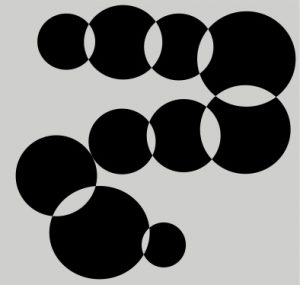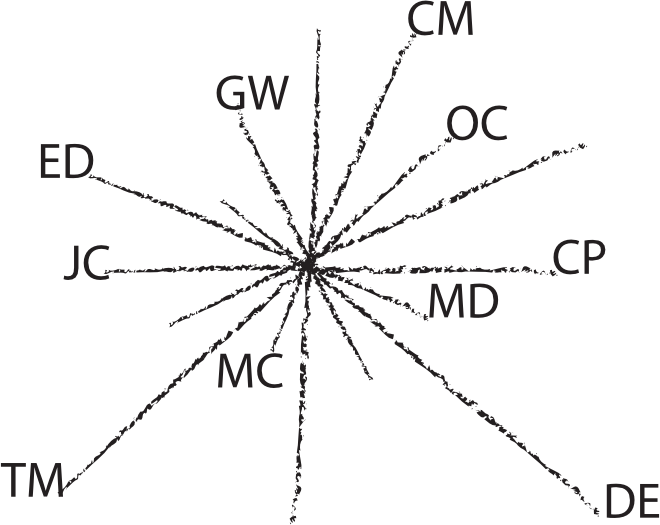Evolving “Circle Music”: Exploring New Horizons
Expanding Circle Music: My Evolving Approach
Following Dr. Cindy McTee’s circle music framework, I’ve made some modifications to the original concepts, creating multi-movement or multi-section works with my circle-music compositions. I’ve decided that the order of fragments or phrases within each section can be entirely flexible. Given the larger instrumentation I use, I found it unnecessary to limit the number of fragments played consecutively without repetition. The phrases naturally recur enough to become familiar to listeners. Additionally, I introduced “performance maps” to guide how the piece transitions between movements. Each composition varies in its specifics, highlighting the versatility of this musical form.



Crafting the Fragments or Phrases
When crafting these fragments, I consciously aimed to create a balance between accompaniment or bassline elements and melodic lines. While performers are supposed to create their own space, in larger ensembles, I felt it was essential to include rests within the fragments to ensure there was enough space for everyone. The performance instructions emphasized that all “rests” must be played. Although it might seem that only atonal music would suit this form, I found it quite feasible to use modal tone centers for a more tonal approach, allowing for switches in tonal centers from section to section.

My Compositions:

My first experiment with circle-music as a form, began with my jazz album The Is by the CKW Trio in 2004, where I sought a new approach to the blues. I deconstructed some my favorite bluesy jazz tunes into short phrases that mirrored the shapes of these songs. The title of this work is actually a symbol with the initials of the composers who inspired the phrases, but it is also known as 21st Century Blues. The rules were simple: the “head” was a “choose your own adventure,” musicians are free to choose, repeat, or leave space for others. The piece opens up to solos, referencing the phrases occasionally, and then returns to the “head.” This method was a fun and effective way to enhance group cohesion and improvisational skills, making it a great choice for early performances in concerts.
Ha-Me’aggel
The next circle-music piece was a jazz composition on my subsequent CD, an indefinite suspension of the possible by Cooke Quintet in 2006. This piece took a different approach, featuring four sections or movements played contiguously but in any order. The quintet connected these sections via live improvisation, occasionally inviting audience members to decide the sequence as we performed. The melodies, written using a Klezmer scale, and were inspired by the story of Onias (Honi) Ha-Me’aggel, a first-century Jewish scholar who prayed for rain within a drawn circle, and his prayers were mysteriously answered. Thus, the piece is named Ha-Me’aggel. This should not be confused with Ha-Me’aggel for Orchestra, which is based on the original work but follows a fixed order.
Sun & Moon
I then made the leap from jazz ensemble to orchestra. Sun & Moon, written in 2008 and premièred by the SFCCO that same year, is structured around 16 distinct fragments in each movement, granting performers the autonomy to determine their sequence during performance. In this format, a performer selects and interprets a fragment, influencing their approach to the subsequent fragment, creating a continuous, reflective musical dialogue.
The “Sun” movement is more atonal, featuring more leaps and disjointed fragments at faster tempos to effectively represent the sun. In contrast, the “Moon” movement is more tonal, with longer notes and fewer leaps, creating a calmer feeling to represent the moon. The two movements blend together, effectively making it a “single-movement” work with three distinct sections: Sun only, Sun & Moon mixed, and Moon only.
Key performance instructions include:
- The tempo is set by each performer within the prescribed range on the score/part.
- Performers should “play” all the rests.
- Performers should listen to the surrounding sounds and adjust their volume and musicality accordingly.
- Performers may stop and take a break as needed.
The conductor is responsible for bringing performers in, transitioning them between movements, and shaping the music. There is a “performance map” for the conductor to follow, which indicates the energy level of the piece, the number of players, and which movement the performers should be in. This provides more instructions than Cindy McTee’s ramp instruction, necessary due to the larger group size.
Sun & Moon

In 2022, I wrote 10 Circles, which premièred that same year by the SFCCO. This piece comprises ten distinct sections, each containing musical phrases that can be played in any sequence at any time. This fluid approach to composition demands a novel style of conducting. Here, the conductor is more than a timekeeper; they sculpt the piece in real-time, shaping its orchestration dynamically. Some Circles are designated for only strings or low instruments, and it is the conductor’s responsibility to bring instruments in and out.
Most Circles overlap as the conductor transitions performers into the next section, except for Circle 8, where everyone moves simultaneously in an instant shift. A tonal center changes at that moment as well increasing the impact of the change. Musicians navigate their routes through the sections, guided by the surrounding sonic landscape. Themes may reappear, but their occurrence and interpretation are unpredictable. Circle 10 has special instructions: once everyone is on that circle, they remain on their phrase and crescendo until the conductor ends the piece.
10 Circles employs quartal chords and octatonic scales, creating a sense of tonality that is both tangible and abstract. The result is a work that challenges and redefines our understanding of musical time and structure.
10 Circles
Sun & Moon: Eclipse Variation
The most recent circle-music composition is a new variation of Sun & Moon, the “Eclipse Variation”, 2024, which premièred in May by the SFCCO. Inspired by the April 8, 2024, solar eclipse, this piece retains the phrases and rules of the original Sun & Moon (2008) but introduces a different “performance map” and incorporates vocal performers.
In the “Eclipse” performance, the entire ensemble begins with the “Sun” movement. After about 2 minutes, the conductor gradually transitions players to the “Moon” movement, starting on one side of the ensemble and moving across. This transition takes approximately three and a half minutes, leading to a full “Moon” section. At this point, the vocalists are introduced for the first time. This “totality” section should last 3 minutes and 51 seconds—the duration of totality in Dallas.
Subsequently, the conductor cuts off the vocalists and transitions the players back to the “Sun” movement one by one, again over three and a half minutes. The final “Sun” section lasts about 2 minutes before the conductor concludes the piece, with all performers finishing simultaneously.
Sun & Moon: Eclipse Variation
Future Ideas
I envision experimenting with small group or solo instrument circle-music pieces, similar to Cindy McTee’s original concept, and possibly even incorporating her and Stockhausen’s original rules. Additionally, I want to explore mixing circle-music sections with fully notated sections. While I frequently blend aleatoric sections with “box notation” and fully notated sections in my music, I have not yet applied this approach to circle-music style aleatory.
An opposite approach I feel is also possible and do a circle-music piece with a strict pulse. I have the seeds of an idea to write a piece for a Pierrot ensemble but with saxophone instead of clarinet, and possibly 2nd percussionist, to help maintain the pulse. But I’m so behind on the pieces that are in front of this idea I’m not sure when I can start.
I am also intrigued by the idea of creating a composition similar to Ha-Me’aggel, where sections of music can be played in any order, despite the challenges in transitioning between different sections. One concept I’m considering is using circle-music sections as transitions to notated sections that are played in any order, effectively creating “Circles within Circles.” That might just be the name of a new piece!


